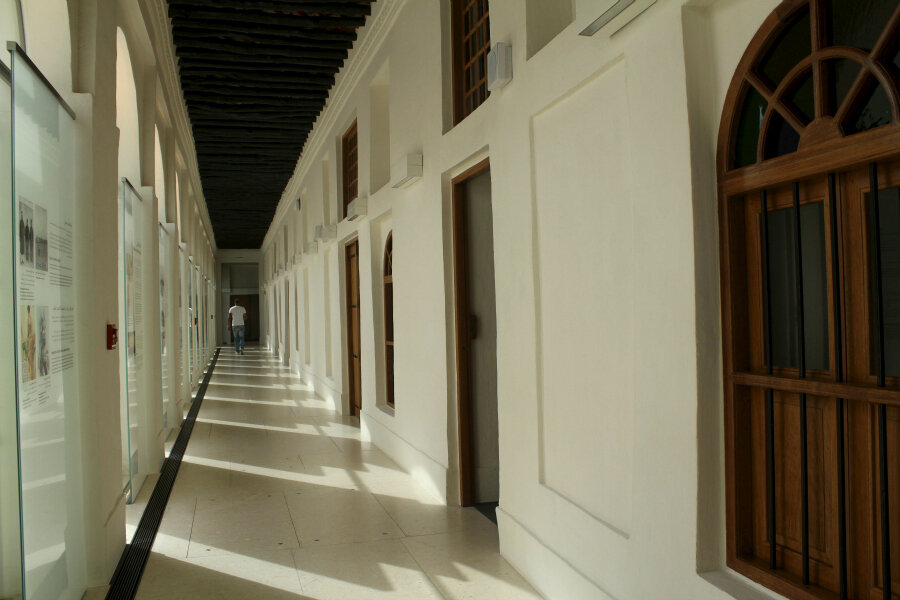Qatar slavery museum aims to address modern exploitation
Loading...
| Doha, Qatar
Amid thatched ceilings and arched doorways in a traditional Qatari house in Doha, a projector beams a quote by Abraham Lincoln onto a wall: "If slavery is not wrong, nothing is wrong."
The Bin Jelmood house in Doha is the first museum to focus on slavery in the Arab world, and it opens as the gas-rich Gulf monarchy faces accusations by rights groups of modern-day slavery of migrant workers before the 2022 World Cup.
Qatar has denied exploiting or abusing workers and says it has implemented labor reforms. The museum itself is funded by the government and was inaugurated last month with a visit by Qatar's Sheikha Moza bint Nasser, the mother of the current emir.
Little discussed in schools and official histories, slavery is tackled head-on by museum directors who believe it has too much to say about their past and future to be ignored any longer.
"Development has been so fast in Qatar, we wanted to look at how things changed, how Qatar was affected by slavery and how slaves were integrated into society," said Hafiz Abdullah, the museum manager.
Slavery in Qatar was abolished only in 1952, and tightly knit populations there and in other Gulf states descend both from African slaves and the Arabs who traded and owned them.
The museum, an old white-washed house whose courtyard was once crowded with East African slaves waiting to be sold, is a rare contemplation of the past in a tangle of high-rise buildings reaching toward the future.
Videos and audio panels chronicle Qatar's role in a lucrative slave-trade network extending across the Indian Ocean and the ordeals of its victims: men pressed into risking their lives pearl diving in Gulf waters and workers brought by force from Africa to work on oil rigs after World War Two.
Antique photos show black slaves standing beside masters and their camels, adopting the flowing robes and waist-belt daggers that marked their slow entrance into Arab culture.
Proceeding deeper into the halls, displays approach the persistence of slavery throughout the world.
An image of Nepalese laborers in blue overalls on a Doha building site carries the caption: "Many construction workers in rapidly industrializing parts of the world, especially the Gulf region, are considered to be contractually enslaved."
With nearly $200 billion worth of infrastructure projects planned before Qatar hosts the World Cup, hundreds of thousands of workers have been recruited from countries such as India, Nepal, and Bangladesh to power Qatar's construction boom.
Rights groups criticize Qatar's "kafala," or work-sponsorship system, that puts foreign workers, who account for 94 percent of its work force, at the mercy of their employers.
The museum explicitly links historic slave-trading to human trafficking and bonded labor.
"The story of slavery did not end in 1952," Abdullah said. "People need to focus on human exploitation today and how we can change that."
Qatar has promised reforms to the kafala system, and in October amended a law on how migrant workers apply to leave the country, which was hailed by local commentators.
"Qatar has abolished the last manifestation of slavery," Qatari columnist Mohammed al-Qahtani posted on Twitter, referring to the current sponsorship system as a "monopoly over human souls."
Human Rights Watch said the reforms don't go far enough – they still require workers to get their employer's permission to change jobs or leave the country.
In the museum's final room visitors are encouraged to raise a hand to symbolize their rejection of slavery and take a selfie that is projected onto a mosaic on the wall – a gesture which may provide little comfort to low-wage workers nearby.
Joel Cabrera, a security guard from the Philippines who earns 1,200 riyals ($330) a month working on a building site near Bin Jelmood house, said he hadn't heard about the museum but would be interested in visiting.
"People have been exploited in every country throughout history. I guess it's about whether lessons are learned from the exploitation, and how willing are people to accept that kind of thing today," he said.







